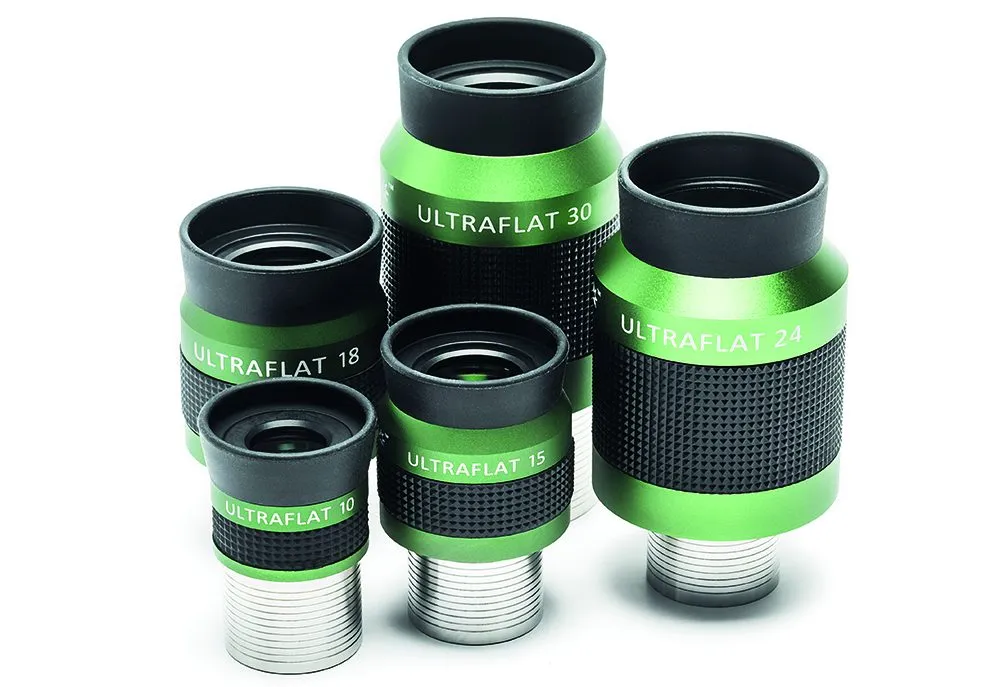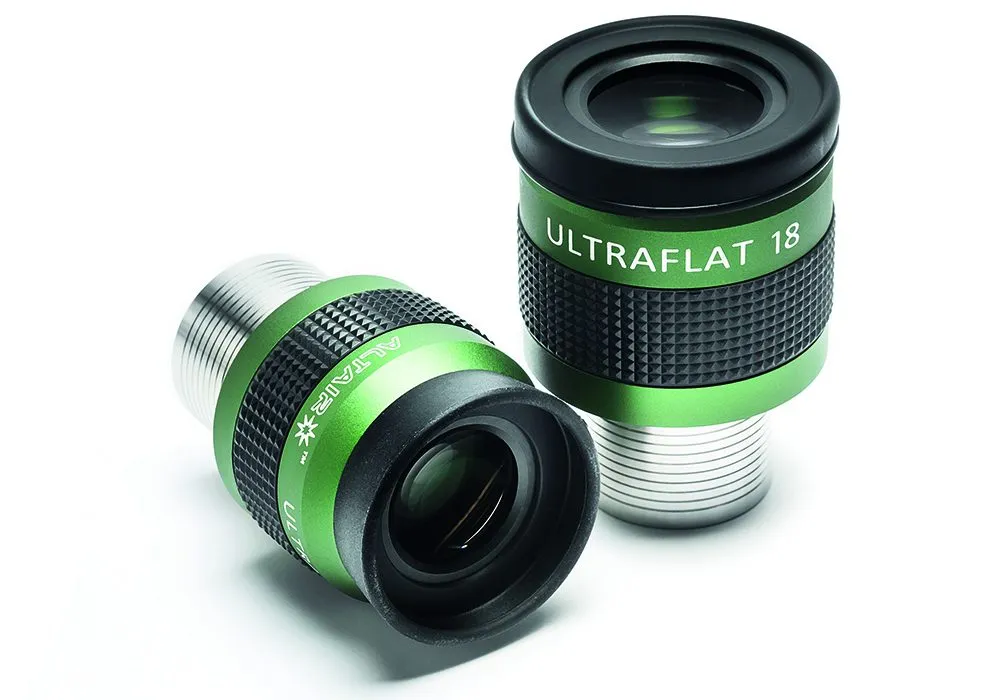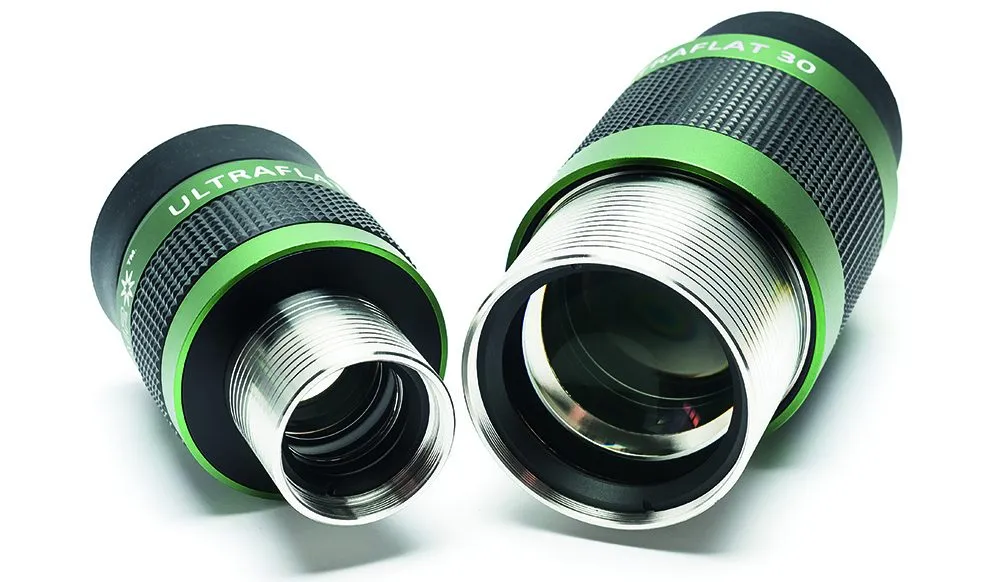Altair’s new Ultraflat eyepiece collection has been specifically designed to help correct field curvature, an aberration that results in stars towards the edges of the field of view taking on an elongated shape.
But while we were generally impressed with the range, the name ‘Ultraflat’ may be overstating the case.
The eyepieces are very nicely presented in a most attractive satin green anodised finish with a bright stainless steel barrel and contrasting black rubber grip and eyecup.
The focal length of each is printed in white on the green, giving plenty of contrast when viewed using a red light torch. Overall they have a quality feel to them.

The collection comprises oculars with focal lengths of 10mm, 15mm, 18mm, 24mm and 30mm, making them suitable for a wide range of celestial observations although, surprisingly for a collection of this type, the apparent field of view (AFOV) is not common throughout the range.
The 15mm, 18mm and 24mm eyepieces each have an AFOV of 65°, while the 10mm and 30mm have AFOVs of 60° and 70° respectively.
Focus and fit
All of the eyepieces have 1.25-inch barrel diameters except for the 30mm, which demands a 2-inch barrel to achieve its 70° apparent field of view.
This is because the field stop of a 1.25-inch barrel would be a limiting factor here.

To make use of the whole collection you may therefore require an eyepiece adaptor to accommodate both sizes.
The eyepieces all include filter threads in their respective sizes.
We tested the eyepieces to see if they were parfocal – that is, that the focus point stays exactly the same while you zoom the lens – as this can be a very useful attribute when swapping from one eyepiece to another to minimise focus adjustments.
The 18mm and 15mm versions were fully parfocal, with the 24mm and 10mm requiring the smallest of adjustments with less than a millimetre of focus travel to cover them all.
The 30mm version required an extra 11mm of outwards focus travel as we would have expected because its 2-inch barrel didn’t, of course, require the 1.25-inch adaptor which has a depth of 11mm.
Colour correction was generally good, although the 10mm eyepiece displayed a little false colour even on axis.
The field stop in all of the eyepieces was sharply defined and, with the rubber eyecups folded down, could be seen in all of the eyepieces when wearing glasses.
Taking them on tour
We put the eyepieces to the test by observing a range of objects using our own William Optics 2-inch Dielectric Diagonal attached to both our observatory-mounted William Optics FLT 98 apo refractor and our grab-and-go Megrez 72FD scope.
The review period coincided with comet 46P/Wirtanen being well placed and a break in the cloud cover on the night of 13 December, coinciding with the comet traversing Taurus, was too good an opportunity to miss.
Wirtanen proved to be a great object for observing at low power using the 30mm eyepiece in our 4-inch FLT 98.
Three days later, at the crack of dawn, with the 10mm eyepiece in our Megrez 72FD we observed the brilliant planet Venus enjoying a really distinct crescent set against a delightful blue backdrop.
The Pleiades star cluster was beautifully displayed in the 24mm mounted in our FLT 98, and a small slew to the east on 16 December brought us back onto the comet for another enjoyable look.
At around this time we also enjoyed some fantastic views of the Moon using the 10mm and 15mm eyepieces and caught tantalising glimpses of Mare Humboldtianum on the northeastern limb.
The 18mm eyepiece produced a lovely framing of M42, the Orion Nebula, and the Running Man Nebula.

We chose Betelgeuse as our star test subject and found that each eyepiece produced well-formed stars out to over 85 per cent of the field of view in our FLT 98 refractor, which is very respectable but not what we’d call ‘ultra’ flat.
We liked this collection of eyepieces as they produced excellent views, although we didn’t particularly feel that they had a marked effect on field flatness.
However, they are still a good range and we would recommend them to both beginner and intermediate observers.
Ultraflat or not?
Nearly all telescopes suffer from field curvature to some extent, resulting in only the stars at the very centre of the field of view – those that are ‘on-axis’ – being in perfect focus.

The further off-axis you look, the greater the amount of distortion in the star shapes. Although field curvature is a big issue for astrophotographers, it isn’t for observers as eyepieces and the human eye and brain tend to compensate.
The Altair Ultraflat eyepieces aim to form distortion-free images right up to the field edge, even in very fast focal ratio telescopes.
We tested the effect of off-axis distortion through a high-quality refractor by observing a bright star centred in each eyepiece, turning off the mount tracking and noting the point at which distortion became noticeable as the star traversed the field of view.
Generally, while the Ultraflat eyepieces produced excellent views, we were not able to observe any marked effect on field flatness in comparison with other eyepieces that we’ve used.
Fold-up rubber eye cup
It is important to shield the observer’s eye from stray light and to allow for steady and repeatable eye placement when observing.
The rubber eye cups on these eyepieces do this very well and can be folded down for spectacle wearers.
Rubber grip
Outside in the cold and dark it is all too easy for a prized eyepiece to slip from your grasp with potentially disastrous consequences.
Manufacturers go to some lengths to make their eyepiece bodies ergonomically friendly to help prevent such mishaps. The textured rubber grip on the Ultraflats is very effective.
Safety kerfs
Although not unique to this range of eyepieces, the lens barrels of the Ultraflats have been machined with multiple grooves every 2mm.
These are known as ‘safety kerfs’ and they provide an excellent grip for the compression rings found on most modern eyepiece holders, while obviating the risk of snagging.
1.25-inch and 2-inch barrels
Modern eyepieces have barrels in two sizes. Most popular is 1.25-inch, but the needs of very long focal length oculars or those with very wide fields of view dictate a larger diameter.
All the eyepieces in this collection are 1.25-inch push-fit, with the exception of the 30mm eyepiece with its 2-inch barrel.
Multi-coating
In telescopes and eyepieces it is important to minimise the light reflected from the lens surfaces so that maximum light passes through to the observer’s retina.
Multi-coatings that reduce reflections have been applied well on these Altair eyepieces.
Vital stats
- Price: £65, £89, £99, £135, £169
- Focal length: 10mm, 15mm, 18mm, 24mm, 30mm
- Apparent field of view: 60°, 65°, 65°, 65°, 70°
- Eye relief: 16mm, 16mm, 20mm, 29mm, 22mm
- Optical elements: 4, 8, 8, 8, 9
- Barrel size: 1.25-inch (10–24mm eyepieces), 2-inch (30mm eyepiece)
- Weight: 109g, 172g, 245g,431g, 676g
- Extras: Lens caps, microfibre cloth
- Supplier: Altair Astro
- Tel: 01263 731505
- www.altairastro.com
This review originally appeared in the March 2019 issue of BBC Sky at Night Magazine
